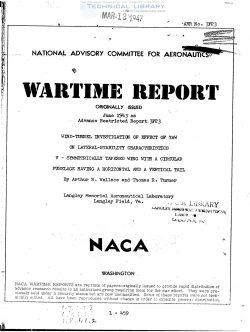naca-wr-l-459
- Version
- 133 Downloads
- 1.03 MB File Size
- 1 File Count
- April 3, 2017 Create Date
- April 3, 2017 Last Updated
Wind Tunnel Investigation of Effect of Yaw on Lateral Stability Characteristics - V - Symmetrically Tapered Wing with a Circular Fuselage Having a Horizontal and a Vertical Tail

SUMMARY
Tests were made in the LHAL 7— by 10—foot tunnel to
determine the effect of a horizontal tail on the lateral—
stability characteristics of a high—wing, a midwing. and
a low—wing monoplane. The model combinations consisted
of a circular fuselage, an NAGA 33012 tapered wing. and
an NAOA 0009 horizontal tail surface. Each wing—fuselage
combination was tested with a partial—span split flap
neutral and deflected 60 and with and without a single
vertical tail. Tests were also made of the fuselage with
and without the tail surfaces.
The effect of the horizontal tail is shown in the
presentation of the results in the form of increments of
the rate of change in the coefficients of rolling moment.
yawing moment, and lateral force with yaw caused by wing—
fuselage interference. The coefficients at high angles
of yaw for all model configurations are presented. The
data are compared with data from similar model combiner
tions without the horizontal tail.
The addition of the horizontal tail was found to
reduce tho variation of the wing—fuselage interference and
the change in the effect of wing-fuselage interference on
the vertical tail with vertical position of the wing on
the fuselage. Theflprcsonce of the horizontal tail increased
the effective aspect ratio of the vertical tail by 20 to 60
percent, depending on the angle of attack. For angles of
yaw larger than about 15° the horizontal tail slightly re—
duced the effectiveness of the vertical tail.
'INTEODUOTION
Considerable data are available for the evaluation
of the effect of aerodynamic interference between wing,
fuselage, and vertical tail on lateral—stability charac—
teristics (references 1, 2, and 3). These data-indicate
that the vertical—tail effectiveness is greater with the
wing in a low position on the fuselage than with the wing
in a high position. Air—flow surveys in the region of
. the vertical tail showed that the change- -in tail effective—
ness with wing position resulted from a side flow the
magnitude and direction of which were functions of wing
position (reference 4). Because the data of references 1
to 4 were obtained for models without a horizontal tail,
the question arises as to whether a horizontal tail will
modify these results. The horiaontal tail has been knewn
to increase the effectiveness of the vertical tail by not—
ing as an end plate. A theoretical analysis.of this end—
plate effect was made in reference 5.
The present report continues the -investigation of
lateral—stability characteristics by adding a fourth part.
the horizontal tail, to the previous model consisting of
a wing, fuselage, and vertical tail. The purpose of the
present report is to determine to what extent the hori—
zontal tail influences the effect of wing—fuselage inter—
ference on the vertical tail and to determine experimen—
tally the end—plate effect of the horizontal tail on the
vertical tail. .
MODEL AND APPARATUS
The tests were made in the LHAL 7— by 10—foot tunnel
with the regular six—component balance. The tunnel and the
balance are described in references 6 and 7.
The model (fig. 1) was identical with the circular
fuselage and symmetrically tapered wing model of refer"
ence 1 except for the addition of the horizontal tail sur—
face. For the midwing combination the chord line of the
wing was placed on the center line of the fuselage. For
the high— and the low—wing combinations the surface of the
wing was made tangent to the surface of the fuselage. The
wing was set at O incidence with respect to the fuselage
center line for all cases.
-w-The-3:l symmetrically tapered wing used~in_the_tests
was previously used in the investigation reported in ref—
erence 1. It has an EAOL 23012 section and the maximum
upper—surface ordinates are in one plane, wsth the result
that the chord plane has a dihedral of 1.45 . The wing
tips are formed of quadrants of approximately similar
ellipses. The sweepbaok of the locus of quarter—chord
points is 4.75°, the area is 4.1 square feet, and the as—
pect ratio is 6.1.
| File | Action |
|---|---|
| naca-wr-l-459 Wind Tunnel Investigation of Effect of Yaw on Lateral Stability Characteristics - V - Symmetrically Tapered Wing with a Circular Fuselage Having a Horizontal and a Vertical Tail.pdf | Download |

Comment On This Post